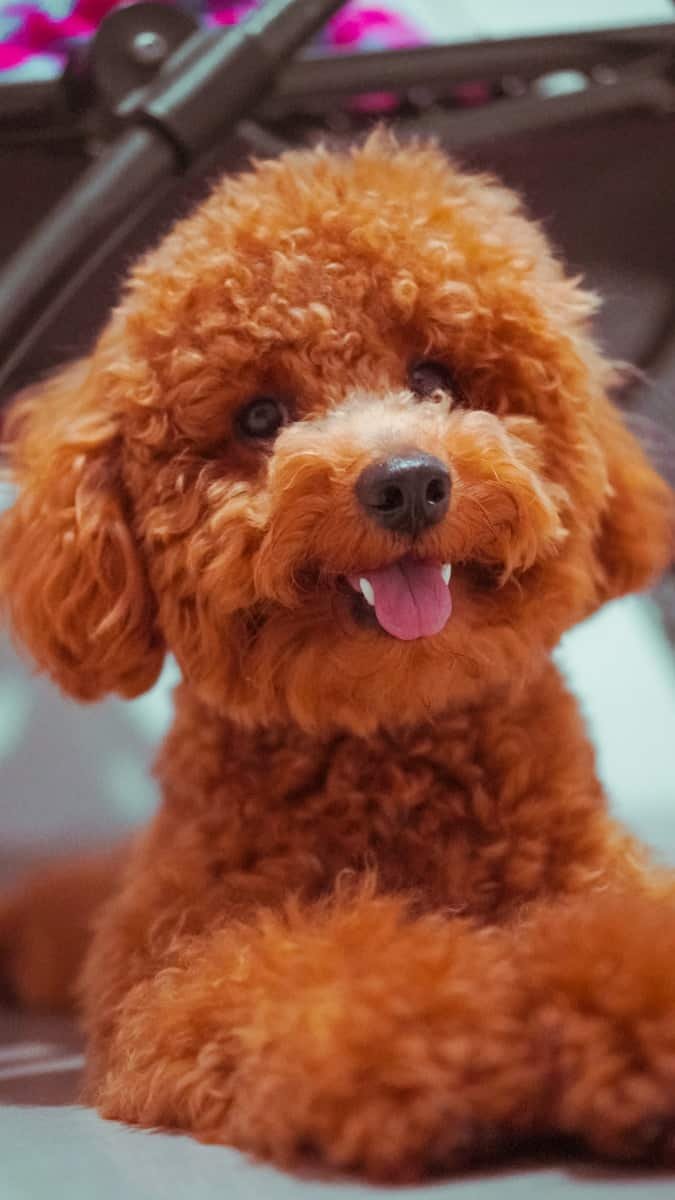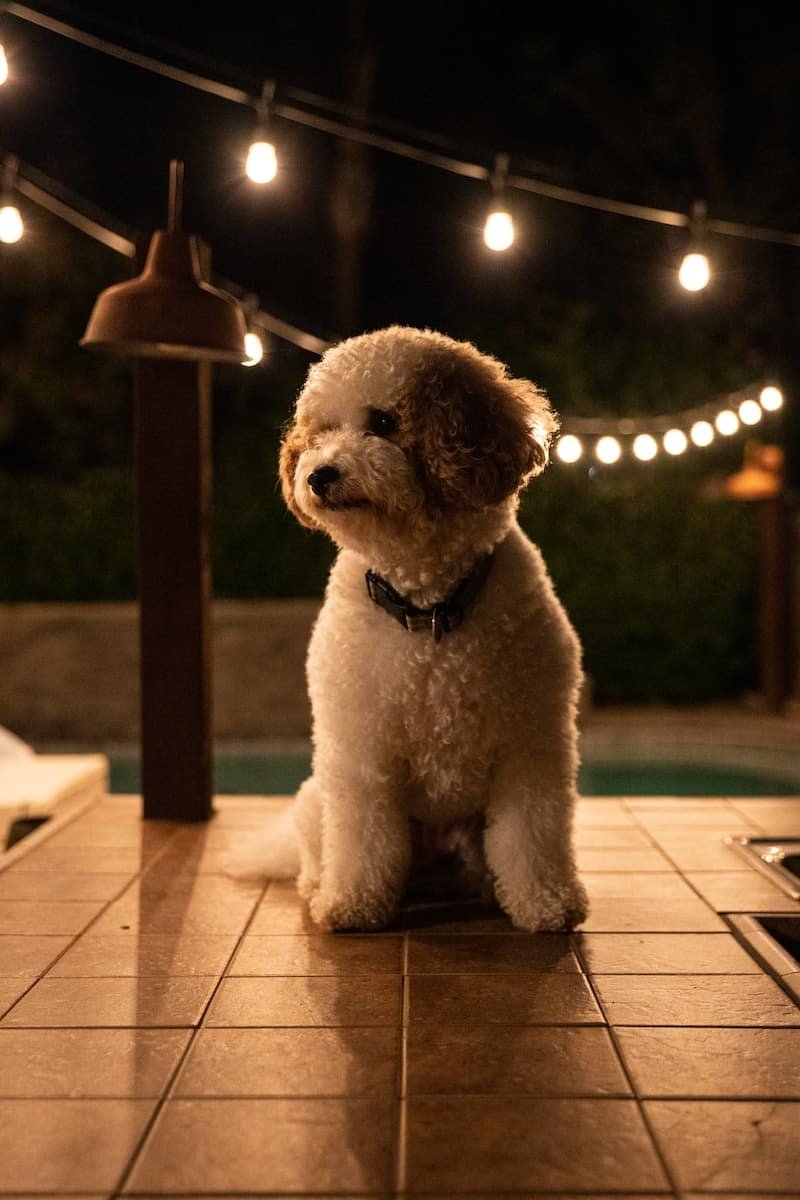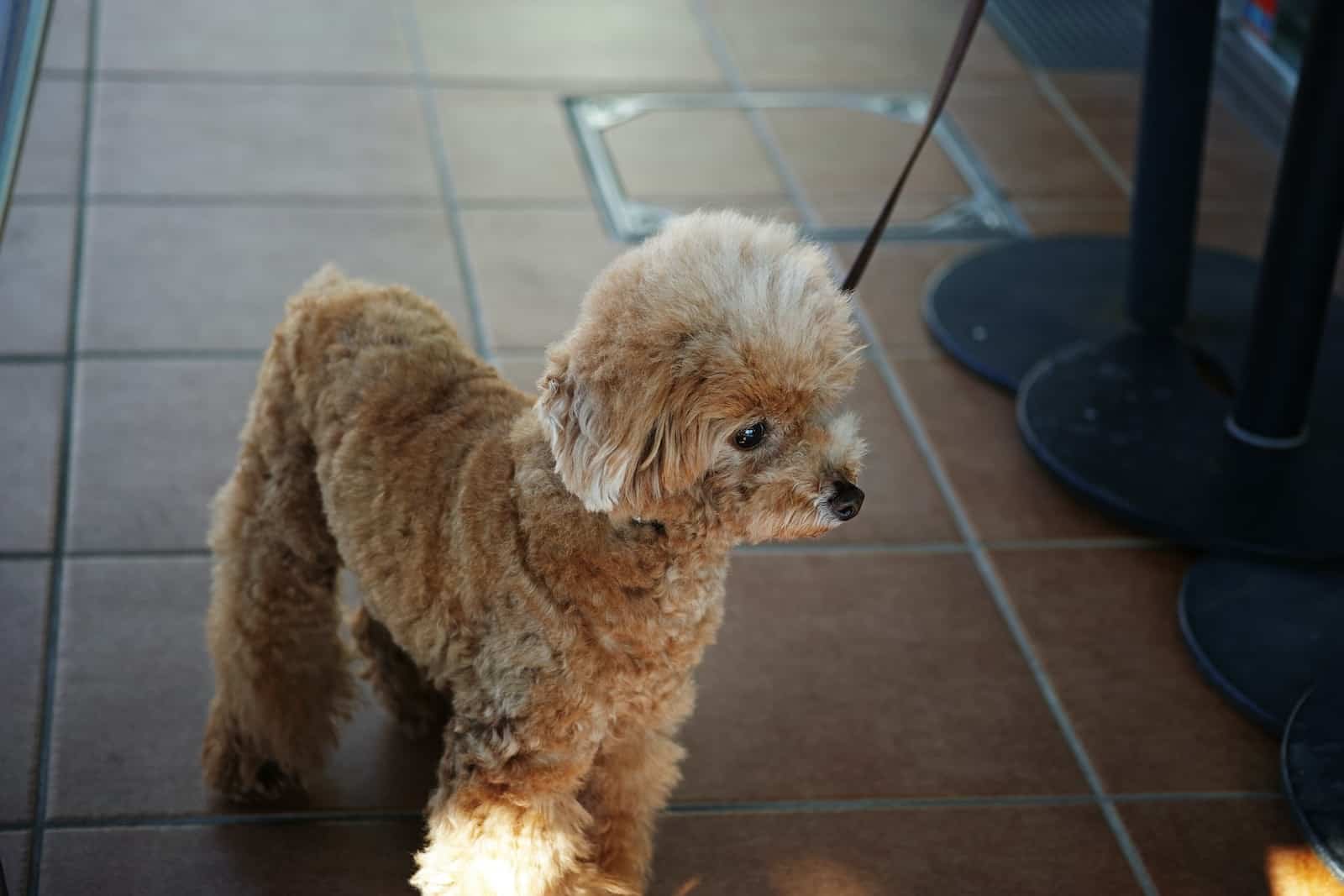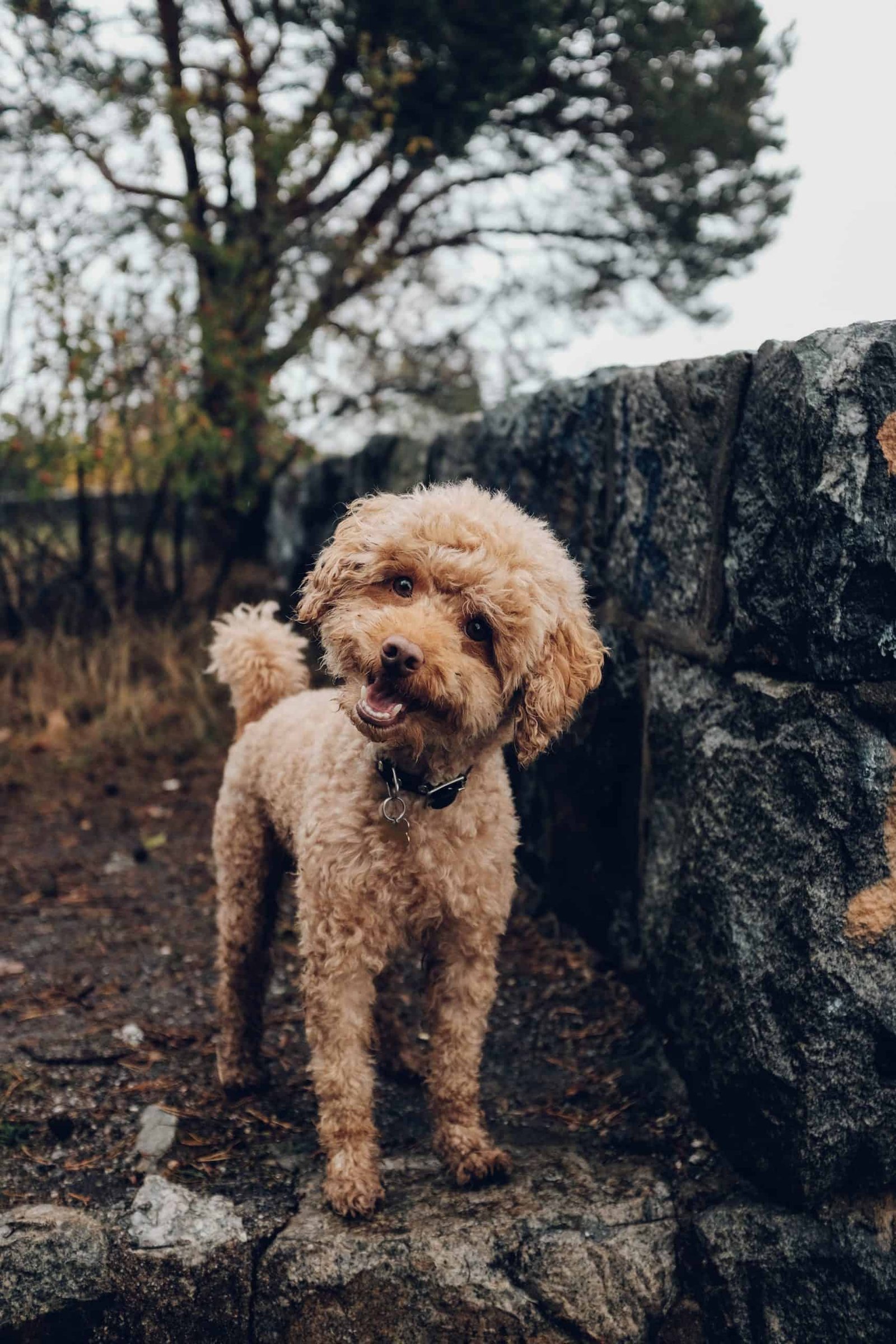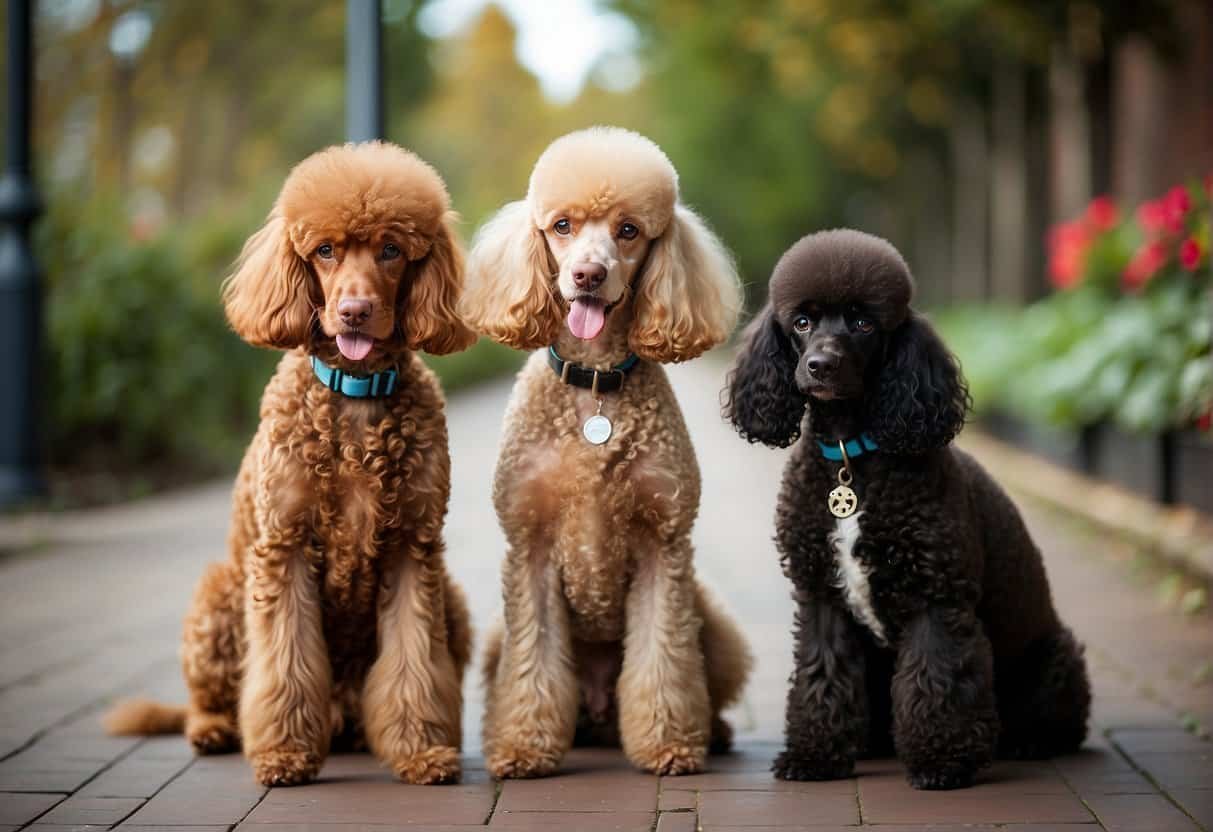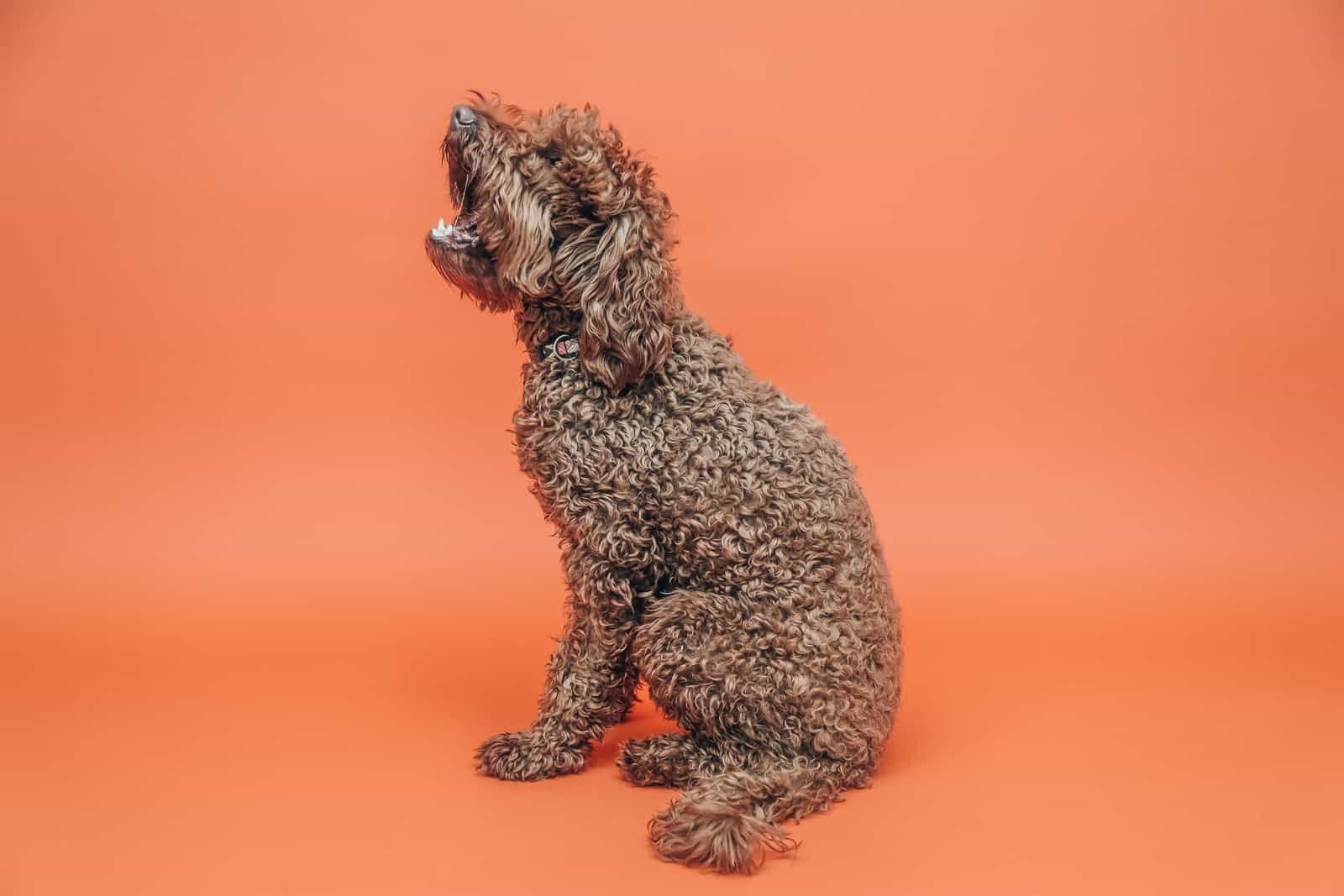Poodles are instantly recognizable and can create images of overly pampered pets, complete with hair-bows and painted toenails. However, this assumption may overshadow their intelligence, often ranking in the top five.
Many people believe this breed originated in France, and for this reason, they are sometimes referred to as “French Poodles.” However, evidence suggests that the breed actually originated in Germany, serving as water dogs for retrieving fowl and game from lakes and rivers.
However, the world seems to disagree with the Poodle’s origin because various other countries also make claims, such as Portugal, Denmark, Africa, and Spain. Wherever they originally came from, one thing is undisputed. Poodles are popular.
Let’s dive in and learn about the different breeds.
Poodle Type:
- Standard
- Moyen
- Miniature
- Toy
- Teacup
However, there is also a Royal Standard breed that we will group under the purebred Standard Poodle. Also, there are several mixed breeds, and we will explore a few of the most popular ones.
Standard Poodle
If you have ever seen a tall version, it was probably a Standard Poodle. These majestic dogs can be up to 15 inches tall. The males weigh between 60 and 70 pounds, while the females weigh between 40 and 50 pounds.
These dogs are athletic dogs and extremely intelligent. They’re also some of the most handsome dogs in the world. These purebreds move quickly and are fast thinkers, so they need plenty of daily exercise and much attention from companions.
This breed has long curly coats, so they need to be trimmed and clipped every four to six weeks. However, the good thing about their hair is that it’s mostly hypoallergenic, making this breed an excellent family pet. Equally significant, their coat sheds minimally.
The Standard Poodle breed excels in obedience classes and at competitive obstacle courses. In fact, most experts recommend owners enroll their dogs in advanced training classes because these dogs thrive on mental stimulation.
Royal Standard Poodle
We list this breed under the Standard Poodle because, technically; they are the same breed. What makes the Standard and the Royal Standard different?
The Royal Standard breed is both heavier and taller than the Standard Poodle; growing to exceed 25 inches in height and can weigh between 60 and 70 pounds as adults. Contrast this with Standard Poodles, which grow to be about 15 inches tall at the shoulders and weigh only 60 pounds.
Moyen (Klein) Poodle
Also called medium Poodles, the Moyen is an energetic and fun-loving dog. This breed loves being the center of attention, and similar to a purebred Standard Poodle, the Moyen needs a lot of mental stimulation and exercise.
Note that Moyen Poodles are not recognized by the American Kennel Club as a good size variant. The UKC treats Moyens like Standard Poodles when they compete in dog shows.
This breed is smaller than the Standard yet larger than Miniature and Teacup Poodles.
Moyens are widely believed to be one of the dog breeds that are easiest to train. They also have loving and friendly temperaments, so they make wonderful family pets.
Unfortunately, Moyen breeds have more genetic health problems than some other breeds, so this is not a low-maintenance dog breed. They are susceptible to progressive retinal atrophy and cataracts, which will eventually cause blindness.
Moyen Poodles are also susceptible to epilepsy, patellar luxation, hypothyroidism, hip dysplasia, glaucoma, and more. They’re also one of the most expensive Poodle breeds.
This video has a good explanation of the Moyen:
Miniature Poodle
If you are hoping for a sweet and small dog, a Miniature Poodle may be the perfect dog for you or your family. These little dogs grow between 10 and 15 inches tall and only weigh between 10 and 15 pounds.
Miniatures are loved for the same reasons people love many smaller breeds. They’re playful, extremely active, easy to train, and obedient.
Since these dogs are so small, you can bathe them yourself in a half-hour or less. They do still require clipping and trimming, and they will look best if groomed by a professional.
Like the larger breeds, Miniatures thrive in obedience classes and training programs. However, as long as they have some solid mental stimulation every day, they will be lucky dogs.
Miniatures. They come in two different builds. The square build is the correct build, and these dogs are athletic. However, some have chondrodysplasia, which is a slight deformity. Dogs who have this have a longer back and shorter legs. This keeps them from being as agile.
Toy Poodle
Do you want a designer dog breed that is super small? Maybe you live in a small house or apartment? A Toy Poodle may be exactly what you’re looking for. These dogs are smaller than Miniatures. They are no taller than 10 inches tall and weigh between four and six pounds.
Toy Poodles are friendly dogs, but they have more anxiety than other breeds. For this reason, they can display hyper-sensitive behavior around strangers, small children, and other animals in their homes. Specifically, they can be quite aggressive with people they don’t know.
Equally important, a Toy Poodle can suffer from severe separation anxiety, and they thrive on a routine. The good thing is that they are a very intelligent breed and will memorize their owner’s way. They will even grow to expect when you’re preparing to do something.
This video explains the differences between Toy and Miniature Poodles:
Teacup Poodle
The Teacup Poodles are the smallest, yet most expensive breed in this dog class. In fact, they can cost up to $7,500.
Because they are so tiny, these dogs are at risk of broken bones, so you need to be hyper-aware when you have a dog this tiny in your home. Like other Poodles, they are intelligent, loyal, and friendly, so they need a lot of time and attention from their humans.
Teacups are fun-loving dogs, but they’re the most high-maintenance of all the Poodle breeds.
The video below helps showcase the differences between the Toy and the Teacup Poodle:
Bonus: Poodle Mixes
Mixed breeds (also called Doodle dogs) come in dozens of varieties and are much more common than purebreds.
Labradoodle
A Labradoodle is a mix between a poodle and a Labrador. These dogs are hugely popular because they have loving personalities and are very affectionate. They were bred originally to be guide dogs, so they’re highly intelligent.
Labradoodles shed little and are hypoallergenic. They can be shaggy dogs, but that just makes them even cuter. They also need plenty of exercise and attention.
Goldendoodles
A Goldendoodle is also phenomenally popular crossbred with a Golden Retriever. This breed combines the best of two of the most popular dog breeds, and that means that if you have a Goldendoodle, you have an excellent dog.
These make good beginner dogs, so they are perfect for someone owning their first dog.
Goldendoodles are friendly and easygoing dogs. Also, you can expect them to be playful and loyal, so they’re the perfect dog for young children.
Goldendoodles are minimal shedders and hypoallergenic. However, they can get extra hairy, so they need regular brushing and frequent trims to keep their beautiful coat under control and clean.
Peekapoos
A Peekapoo is a crossbred with a Pekingese, so they are small dogs. Since they are not very large, Peekapoos are great dogs for people living in small spaces.
Peekapoos are loyal and protective little dogs. They make wonderful lapdogs who will sit with you for hours. These dogs suffer from separation anxiety, so they’re not the best dogs for frequent travelers.
Chipoo
A Chipoo is a Chihuahua crossbreed. As one of the newer Poodle mixes, these little dogs have a huge personality and an equally big heart. They have tons of energy for training and love to socialize, exercise, and play.
These dogs are loyal and defensive if they’re provoked. After all, they have all the famous feistiness of the Chihuahua. They need at least an hour of training or playtime every day or may become bored. They also bark more often than some of the other breeds.
Which mix is best for your family?
The mix that is best for your family depends on what you expect from the dog. If you’re looking for a loving companion, you might choose one breed. However, if you need a working dog, another species might work best for you.
Here is a video showcasing Poodle mix breeds:
When selecting your desired breed for your family, it’s a good idea to do extensive research because different species respond vastly differently to young children, travelers, and strangers.
What is the calmest Poodle breed?
Purebreds can be high-strung and active, while if you’re looking for a calm dog, consider a mixed breed. However, the smaller breeds are your best choice if you’re looking for a calm purebred poodle.
What is the calmest mix?
The Bernedoodle is widely believed to be one of the calmest (and laziest!) mixes. Bernedoodles are crossbred with a Bernese mountain dog. These dogs are fluffy and large.
These dogs thrive in low-traffic relaxed households.
What is the healthiest Poodle breed?
Most Poodle breeds are equally healthy, and mixes are healthier than purebreds.
Health issues to be aware of?
Depending on the specific breed, Poodles are susceptible to several different health concerns, including the following.
- Cushing’s Disease – a rare endocrine disorder that affects the pituitary gland. It causes an overproduction of cortisol, which can lead to many health problems including obesity, diabetes, high blood pressure, osteoporosis, depression, anxiety, memory loss, muscle weakness, joint pain, heart failure, stroke, seizures, vision changes, infertility in males, premature aging, skin disorders, hair loss, and even death. The most common symptoms are weight gain.
- Epilepsy – The American Kennel Club has a list of breeds that are prone to epilepsy. es, Poodles being on this list.
- Cardiomyopathy– a condition where the walls of the heart weaken and enlarge, causing congestive heart failure. This disease usually occurs between two and five years old. Symptoms include coughing, exercise intolerance, shortness of breath, rapid breathing rate, lethargy, vomiting, diarrhea, lack of appetite, and sudden collapse. Treatment includes medication and surgery. Hypothyroidism-an underactive thyroid gland resulting in decreased production of hormones necessary for normal metabolism.
- Addison’s Disease – an autoimmune disorder which affects the adrenal glands, causing them to stop producing hormones such as cortisol and adrenaline. This can cause many symptoms, including lethargy, weight loss, vomiting, diarrhea, muscle weakness, depression, anxiety, seizures, coma, blindness, deafness, heart failure, kidney damage, liver problems, bone marrow suppression, and death. It occurs most often in young dogs between 2-5 years.
- Legg-Perthes Disease – an orthopedic disorder affecting the hip joint, which can be hereditary or gained. It affects young dogs between two months and three years old. This condition causes pain and lameness on one side of the dog’s body. There may also swell around the affected area. In severe cases, it will cause deformity of the leg bone.
- Hip Dysplasia – The AKC lists hip dysplasia as one of the most common hereditary diseases affecting dogs, with an estimated prevalence rate of about 30%. Hip dysplasia is caused by abnormal development or positioning of the femoral head within the socket of the pelvis. It can be inherited either through genes passed on from parents who have it themselves, or because puppies born without this condition may inherit defective copies of these genes from their mothers.
- Gastric Dilation-Volvulus – A Poodle with gastric dilation volvulus will have difficulty eating or drinking because his stomach gets twisted around so much he cannot empty himself completely. This causes him pain and discomfort. He may vomit frequently, lose weight rapidly, become dehydrated, and even die if not treated quickly enough. Symptoms include vomiting, diarrhea, lethargy, loss of appetite, weakness, depression, lack of coordination, seizures, collapse, coma, death.
- Sebaceous Adenitis – The sebaceous glands produce oil, which is used for lubrication and protection against the environment. They also secrete an oily substance called sebum into hair follicles. This can cause excessive shedding or greasiness on the coat. It may be hereditary, but it’s not known if this condition runs in families. It occurs most often between two and five years old when they grow their coats out.
- Eye Disorders – Hereditary eye diseases such as cataracts, glaucoma, retinal degeneration, corneal dystrophy, etc., can be inherited from the parents or occur spontaneously. These conditions may cause blindness if not treated early enough. Dogs with hereditary eye problems should have their eyes examined by an ophthalmologist at least once every year, starting when they reach one month old.

